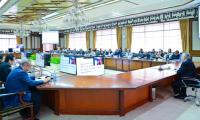ISLAMABAD: Expenditure on pro-poor sectors stood at 9.5 percent of GDP in 2016-17, followed by 9.2 percent of GDP in 2017-18. It dropped to 8.1 percent of GDP in 2018-19 and slightly increased to 8.3 percent of GDP in 2019-20 says Pakistan Economic Survey for 2021. It says in absolute terms, pro-poor expenditure increased to Rs3,447.35 billion as compared to Rs3,009.30 billion in 2018-19 shown.
On March 27, 2019, Ehsaas was launched by Prime Minister Imran Khan as Pakistan’s largest ever social protection and poverty eradication initiative. Ehsaas aims at creation of a ‘welfare state’ by countering elite capture and leveraging 21st century tools—such as using information and digital payment systems, to create a modern safety net programmes; promoting financial inclusion and access to digital services; supporting the economic empowerment of women; focusing on the central role of human capital formation for poverty eradication, economic growth and sustainable development; and overcoming financial barriers to accessing health and post-secondary education.
The programme is unique because of its scale, multi-sectoral character, coverage, design process, management and governance, institutional arrangements and funding. Ehsaas is based on taking a whole-of-government multi-sectoral approach for innovative solutions; ensuring joint federal-provincial leadership; and mainstreaming the role of the private philanthropic sector on the one hand and fosters locally relevant innovation and on the other, protects livelihoods of the most vulnerable.
Ehsaas programme is specially designed for the ultra-poor, orphans, widows, the homeless, the disabled, those who are at risk of health shocks, jobless, poor farmers, labourers, sick and undernourished, students from low-income backgrounds. This plan is also about supporting lagging geographical areas where poverty is higher. Ehsaas’ poverty reduction strategy is articulated in four pillars and it currently embodies more than 140 policy actions, which may be expanded as consultations on the programme are taken forward.
The four pillars include: addressing elite capture and making governance system work for a more equal society; implementing safety net programmes for the disadvantaged segments of the population; supporting jobs and livelihoods; and enhancing human capital development.
College administration is required to appear in person to explain the details of the incident and any actions taken to...
Court observed that the TCP termed it a “shortage”, whereas the Punjab trading agency claims that a substantial...
Anti-Terrorism Special Court Judge Malik Ijaz Asif also announced 32 years in jail and a fine of Rs0.5 million for the...
Two-day conference at the King Abdullah Campus of UAJK aims to chart a course towards sustainable economic growth and...
In Hub, environmental sample was collected on April 17, 2024 from the ‘Jumma Khan Bazar Pul’ environmental sample...
President highlighted that Pakistan was committed to regional connectivity, and the Central Asian countries needed to...






